Discover 35 hidden attractions, cool sights, and unusual things to do in Hamburg (Germany). Don't miss out on these must-see attractions: Hamburger Kunsthalle, St. Pauli, and Museum für Kunst und Gewerbe Hamburg. Also, be sure to include Neuengamme Concentration Camp in your itinerary.
Below, you can find the list of the most amazing places you should visit in Hamburg (Hamburg).
Table of Contents
Hamburger Kunsthalle
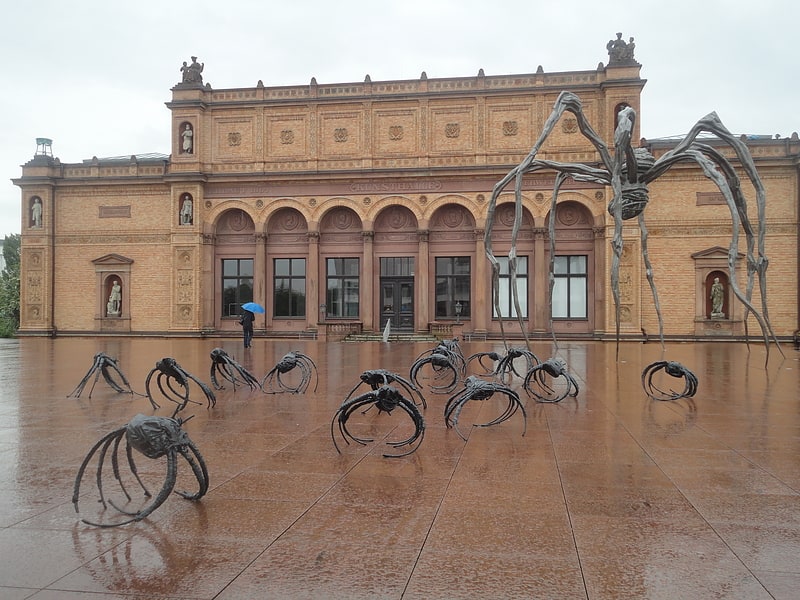
Museum in Hamburg, Germany. The Hamburger Kunsthalle is the art museum of the Free and Hanseatic City of Hamburg, Germany. It is one of the largest art museums in the country. The museum consists of three connected buildings, dating from 1869, 1921 and 1997, located in the Altstadt district between the Hauptbahnhof and the two Alster lakes.
The name Kunsthalle indicates the museum's history as an 'art hall' when it was founded in 1850. Today, the museum houses one of the few art collections in Germany that cover seven centuries of European art, from the Middle Ages to the present day. The Kunsthalle's permanent collections focus on North German painting of the 14th century, paintings by Dutch, Flemish and Italian artists of the 16th and 17th centuries, French and German drawings and paintings of the 19th century, and international modern and contemporary art.[1]
Address: Ferdinandstor 1, 20095 Hamburg (Hamburg-Mitte)
St. Pauli
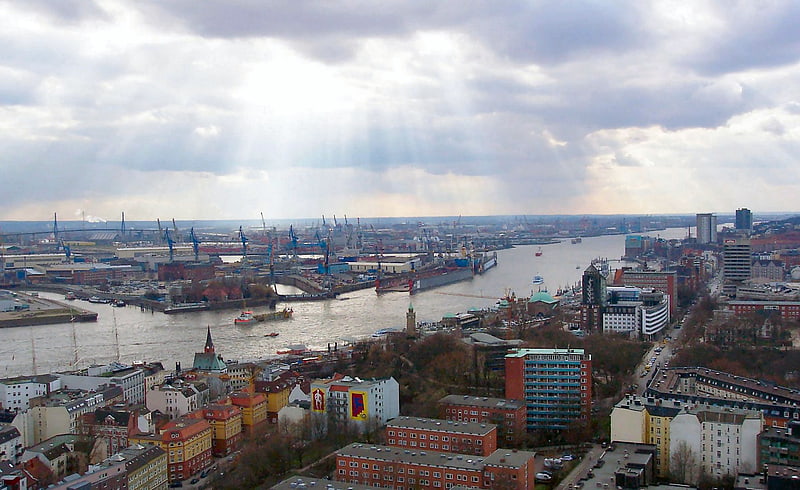
St. Pauli is a quarter of the city of Hamburg belonging to the centrally located Hamburg-Mitte borough. Situated on the right bank of the Elbe river, the nearby Landungsbrücken is a northern part of the port of Hamburg. St. Pauli contains a world-famous red-light district around the iconic Reeperbahn area. As of 2020 the area had 21,902 residents.[2]
Address: 15 Bei der Schilleroper, Hamburg (Hamburg-Mitte)
Museum für Kunst und Gewerbe Hamburg
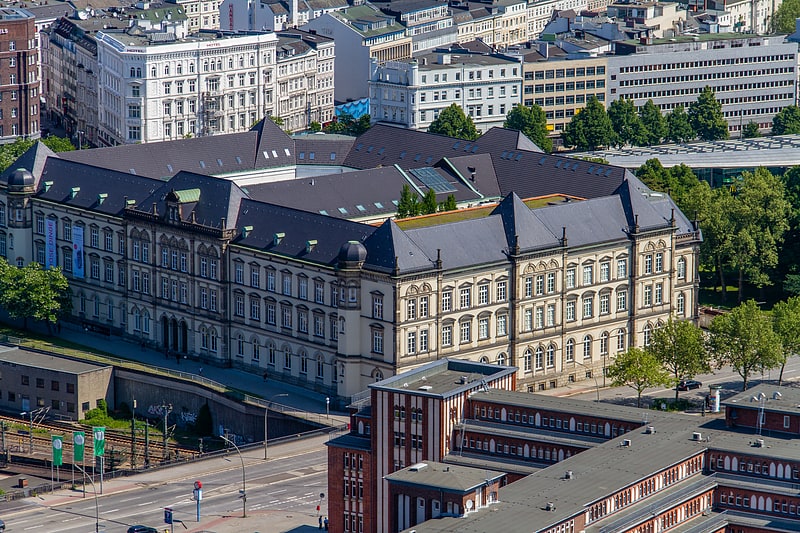
Applied arts, design and industrial museum. The Museum für Kunst und Gewerbe Hamburg is a museum of fine, applied and decorative arts in Hamburg, Germany. It is located centrally, near the Hauptbahnhof.[3]
Address: Steintorplatz 1, 20099 Hamburg (Hamburg-Mitte)
Neuengamme Concentration Camp

Nazi concentration camp in Germany. Neuengamme was a network of Nazi concentration camps in Northern Germany that consisted of the main camp, Neuengamme, and more than 85 satellite camps. Established in 1938 near the village of Neuengamme in the Bergedorf district of Hamburg, the Neuengamme camp became the largest concentration camp in Northwest Germany. Over 100,000 prisoners came through Neuengamme and its subcamps, 24 of which were for women. The verified death toll is 42,900: 14,000 in the main camp, 12,800 in the subcamps, and 16,100 in the death marches and bombings during the final weeks of World War II. Following Germany's defeat in 1945, the British Army used the site as an internment camp for SS and other Nazi officials. In 1948, the British transferred the land to the Free Hanseatic City of Hamburg, which summarily demolished the camp's wooden barracks and built in its stead a prison cell block, converting the former concentration camp site into two state prisons operated by the Hamburg authorities from 1950 to 2004. Following protests by various groups of survivors and allies, the site now serves as a memorial. It is situated 15 km southeast of the centre of Hamburg.[4]
Address: 75 Jean-Dolidier-Weg, Hamburg (Bergedorf)
Hauptkirche St. Michaelis
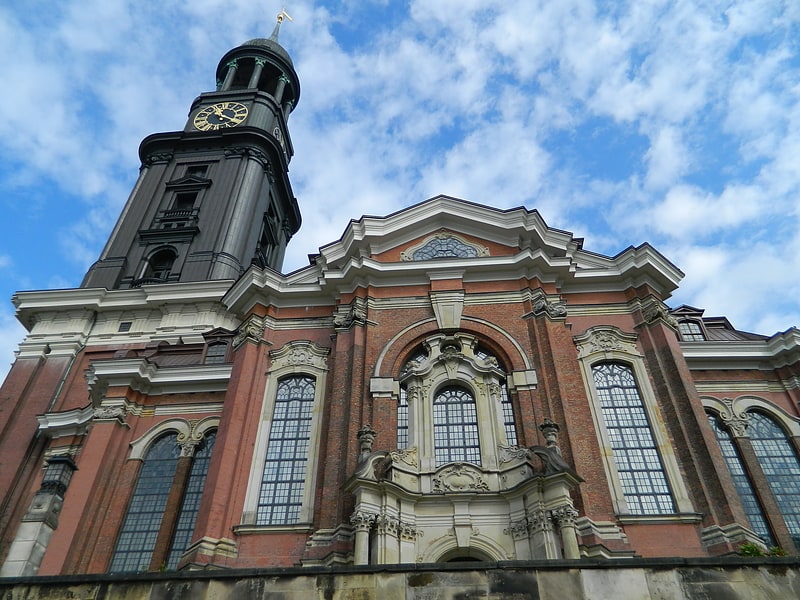
Also known as: Hauptkirche Sankt Michaelis
Lutheran church with a landmark tower. St. Michael's Church, colloquially called Michel, is one of Hamburg's five Lutheran main churches and one of the most famous churches in the city. St. Michaelis is a landmark of the city and it is considered to be one of the finest Hanseatic Protestant baroque churches. The church was purposely built Protestant unlike many other Hamburg churches which were originally built by Roman Catholics and were converted to Protestantism during the Reformation. It is dedicated to the Archangel Michael. A large bronze statue, standing above the portal of the church shows the archangel conquering the devil.
The 132-meter high Baroque spire totally covered with copper is a prominent feature of Hamburg's skyline and has always been a landfall mark for ships sailing up the river Elbe.[5]
Address: Englische Planke 1, 20459 Hamburg (Hamburg-Mitte)
Planetarium Hamburg
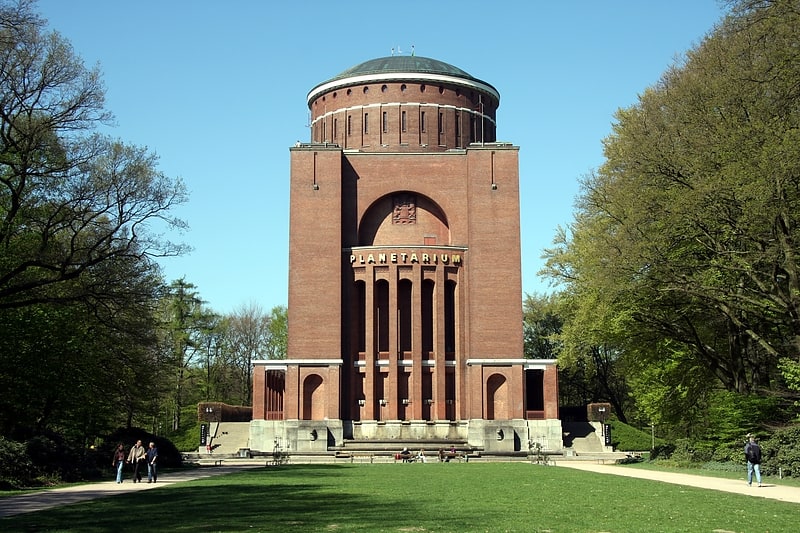
Planetarium in Hamburg, Germany. Hamburg Planetarium is one of the world's oldest, and one of Europe's most visited planetariums. It is located in the district of Winterhude, Hamburg, Germany, and housed in a former water tower at the center of Hamburg Stadtpark.[6]
Address: Linnering 1, 22299 Hamburg (Hamburg-Nord)
City Hall
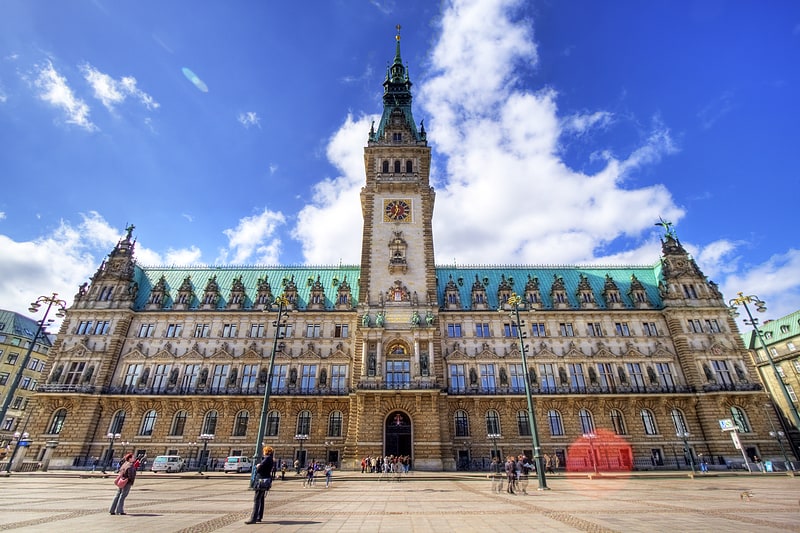
Also known as: Hamburger Rathaus
Grand civic building with guided tours. Hamburg City Hall is the seat of local government of the Free and Hanseatic City of Hamburg, Germany. It is the seat of the government of Hamburg and as such, the seat of one of Germany's 16 state parliaments. The Rathaus is located in the Altstadt quarter in the city center, at the Rathausmarkt square, and near the lake Binnenalster and the central station. Constructed from 1886 to 1897, the city hall still houses its original governmental functions with the office of the First Mayor of Hamburg and the meeting rooms for the Parliament and the Senate.[7]
Address: Rathausmarkt 1, Hamburg (Hamburg-Mitte)
Speicherstadt
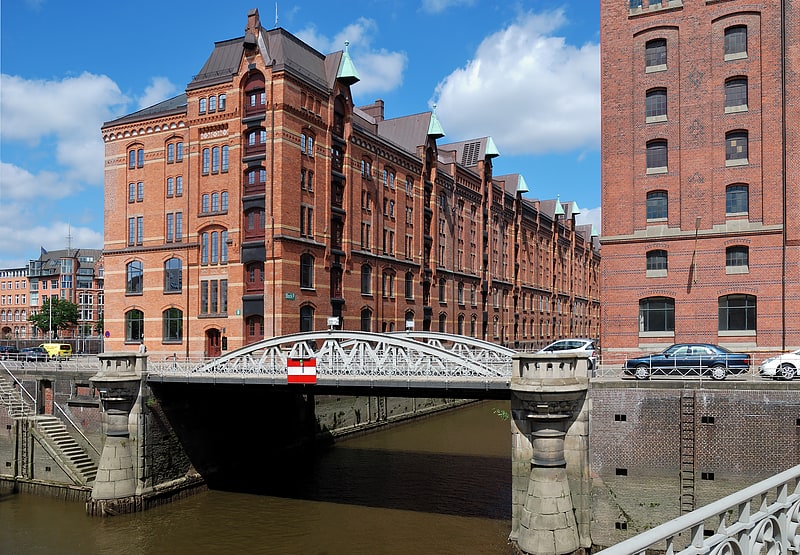
The Speicherstadt in Hamburg, Germany is the largest warehouse district in the world where the buildings stand on timber-pile foundations, oak logs, in this particular case. It is located in the port of Hamburg—within the HafenCity quarter—and was built from 1883 to 1927.
The district was built as a free zone to transfer goods without paying customs. As of 2009, both the district and the surrounding area are under redevelopment. As the first site in Hamburg, it was awarded the status of UNESCO World Heritage Site on 5 July 2015.[8]
Address: Kehrwieder 5, 20457 Hamburg (Hamburg-Mitte)
Internationales Maritimes Museum Hamburg
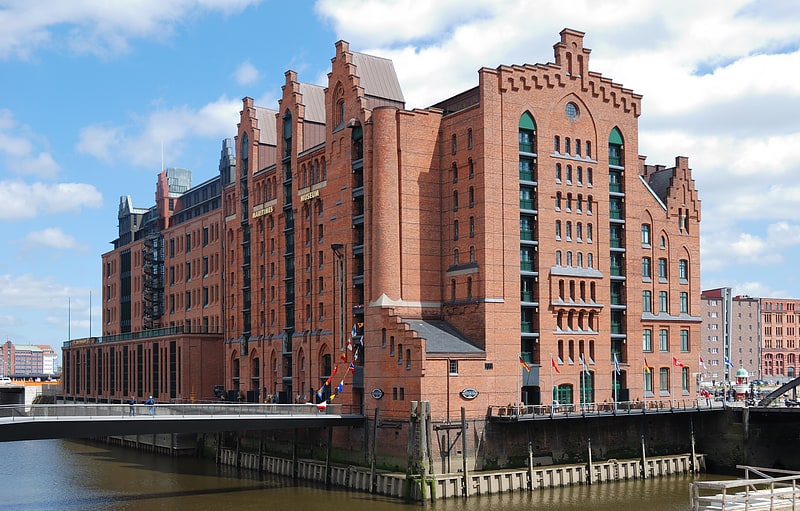
Museum in Hamburg, Germany. The Internationales Maritimes Museum Hamburg is a private museum in the HafenCity quarter of Hamburg, Germany. The museum houses Peter Tamm's collection of model ships, construction plans, uniforms, and maritime art, amounting to over 40,000 items and more than one million photographs. It opened in a former warehouse in 2008.[9]
Address: Koreastraße 1, 20457 Hamburg (Hamburg-Mitte)
Tierpark Hagenbeck
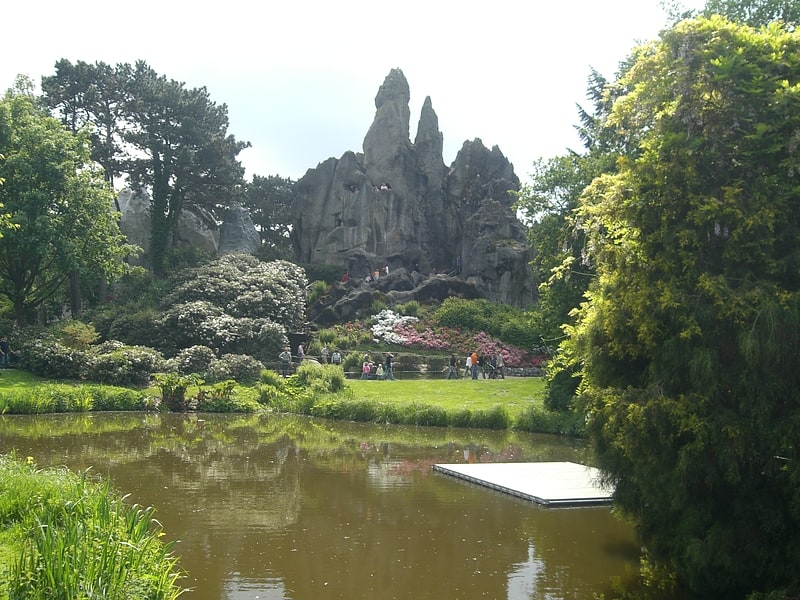
Zoo in Hamburg, Germany. The Tierpark Hagenbeck is a zoo in Stellingen, Hamburg, Germany. The collection began in 1863 with animals that belonged to Carl Hagenbeck Sr. a fishmonger who became an amateur animal collector. The park itself was founded by Carl Hagenbeck Jr. in 1907. It is known for being the first zoo to use open enclosures surrounded by moats, rather than barred cages, to better approximate animals' natural environments.[10]
Address: Lokstedter Grenzstraße 2, 22527 Hamburg (Eimsbüttel)
Museum of Ethnology
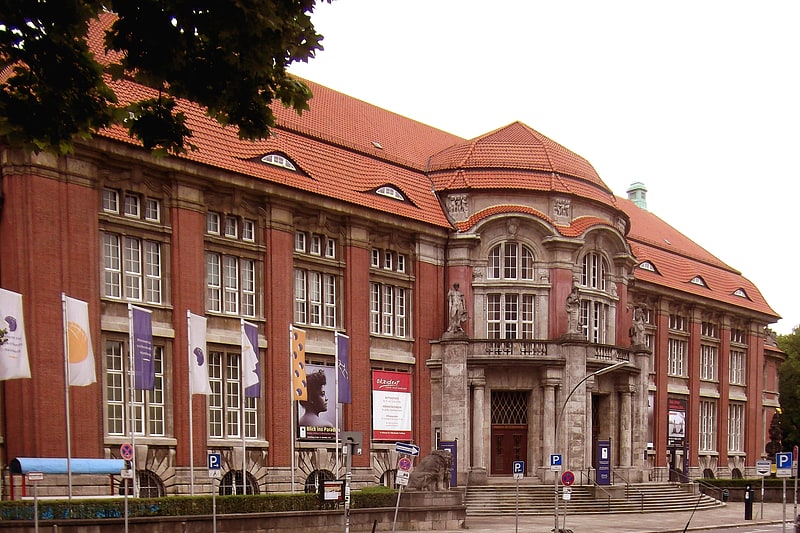
Also known as: Museum am Rothenbaum
Museum in Hamburg, Germany. The Museum am Rothenbaum – Kulturen und Künste der Welt, founded in 1879, is today one of the largest museums of ethnology in Europe. The approximately 350,000 objects in the collection are visited every year by about 180,000 visitors. It lies in the Rotherbaum quarter of the Eimsbüttel borough in Hamburg at the Rothenbaumchaussee avenue.[11]
Address: Rothenbaumchaussee 64, 20148 Hamburg (Eimsbüttel)
Cap San Diego
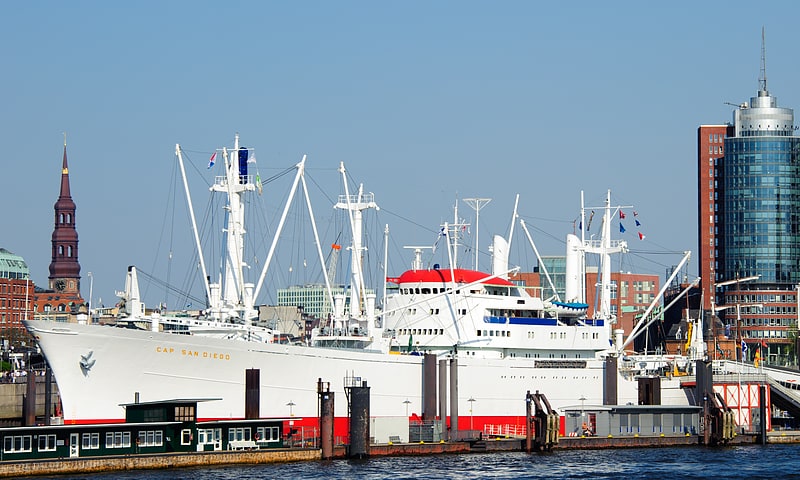
Ship. MS Cap San Diego is a general cargo ship, situated as a museum ship in Hamburg, Germany. Notable for Her elegant silhouette, She was the last of a series of six ships known as the white swans of the South Atlantic, and marked the apex of German-built general cargo ships before the advent of the container ship and the decline of Germany's heavy industry.[12]
St. Nicholas Church
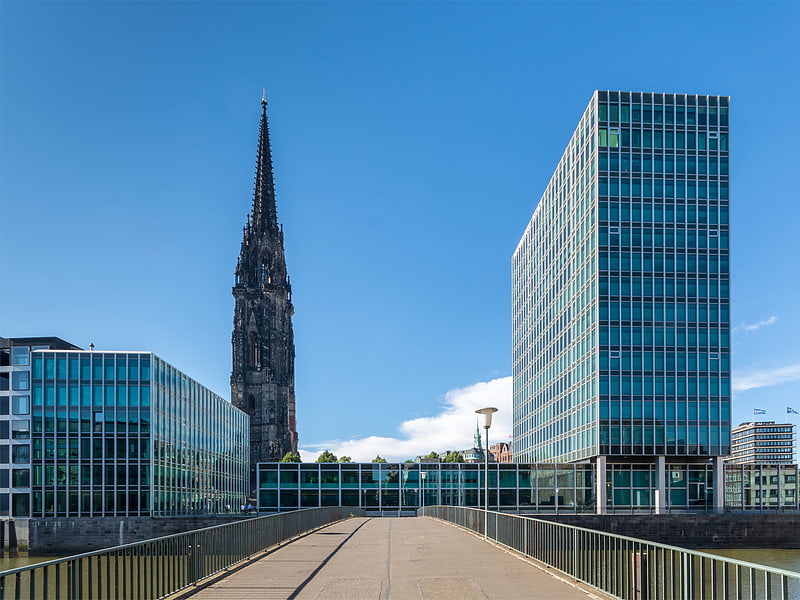
Also known as: Ehemalige Hauptkirche St. Nikolai
WWII memorial with a viewing tower. The Church of St. Nicholas was a Gothic Revival cathedral that was formerly one of the five Lutheran Hauptkirchen in the city of Hamburg, Germany. The original chapel, a wooden building, was completed in 1195. It was replaced by a brick church in the 14th century, which was eventually destroyed by fire in 1842. The church was completely rebuilt by 1874, and was the tallest building in the world from 1874 to 1876. It was designed by the English architect George Gilbert Scott.
The bombing of Hamburg in World War II destroyed the bulk of the church. The removal of the rubble left only its crypt, its site and tall-spired tower, largely hollow save for a large set of bells. These ruins continue to serve as a memorial and an important architectural landmark. When Hamburg residents mention the Nikolaikirche, it is generally to this church that they are referring, and not the new Hauptkirche dedicated to Saint Nicholas in the Harvestehude district. The remains of the old church are the second-tallest structure in Hamburg. In 2005, an elevator was installed to a 75.3-metre-high (247 ft) platform.[13]
Address: Willy-Brandt-Straße 60, Hamburg (Hamburg-Mitte)
Sternschanze
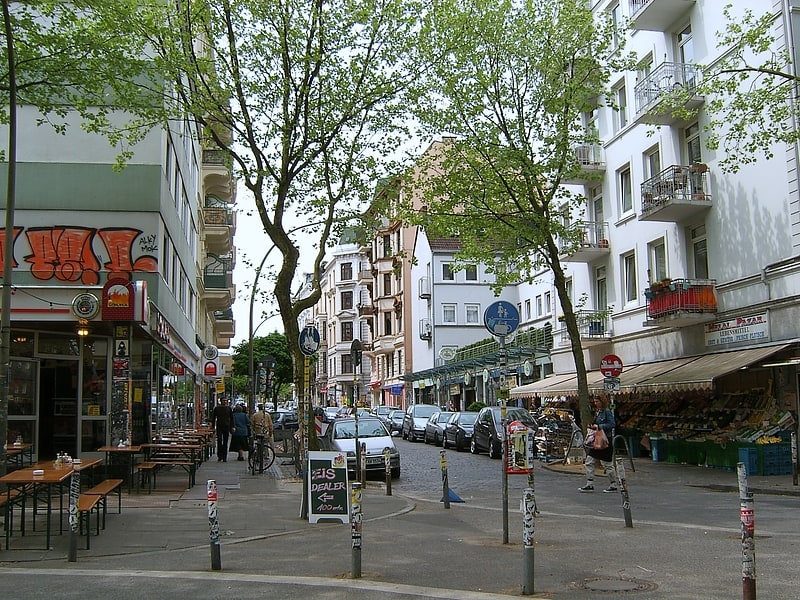
Sternschanze is a quarter in the center of Hamburg within the Altona borough. In 2014, the population was 7,776 on an area of 0.6 sq km with a density of 14,113 inhabitants per sq km. After Reeperbahn, it is Hamburg's best known entertainment and nightlife district. It is also known as Schanzenviertel and nicknamed Schanze.[14]
Bucerius Kunst Forum
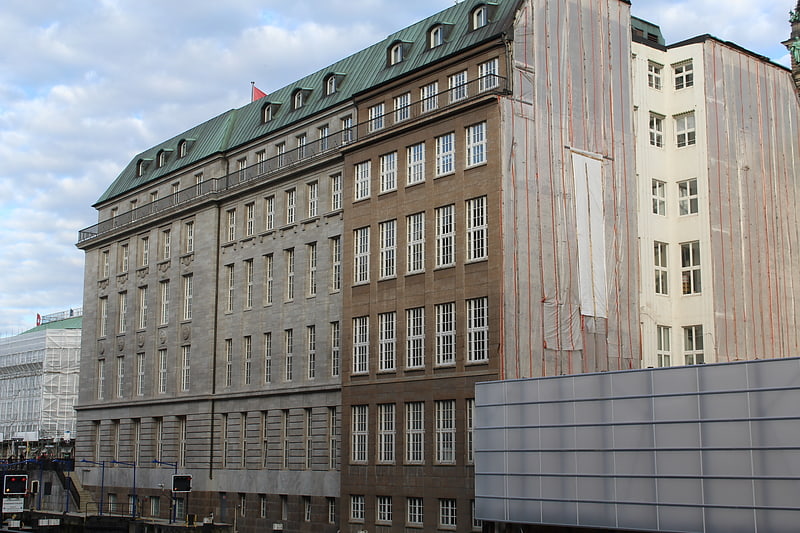
Museum in Hamburg, Germany. The Bucerius Kunst Forum is an international exhibition centre in Hamburg, Germany, founded in 2002 through the ZEIT-Stiftung Ebelin und Gerd Bucerius foundation. It is named after Gerd Bucerius and his wife, and located directly beside the Hamburg Rathaus. The exhibition centre shows 3 - 4 exhibitions per year, in co-operation with other museums and collections. The exhibition centre participates in the Long Night of Museums.[15]
Address: Rathausmarkt 2, 20095 Hamburg (Hamburg-Mitte)
Deichtorhallen
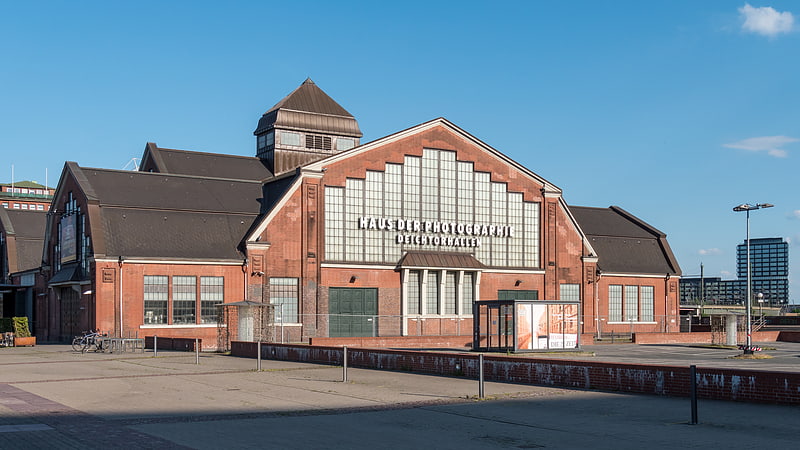
Modern art museum in Hamburg, Germany. The Deichtorhallen in Hamburg, Germany, is one of Europe's largest art centers for contemporary art and photography. The two historical buildings dating from 1911 to 1913 are iconic in style, with their open steel-and-glass structures. Their architecture creates a backdrop for spectacular major international exhibitions.
In 2003 the southern hall was dedicated to the medium of photography, creating the House of Photography. Since 2011, the two buildings at the interface of Hamburg's Kunstmeile and Hafencity have been supplemented by a satellite in Hamburg's Harburg district, the Sammlung Falckenberg.[16]
Address: Deichtorstraße 1, 20095 Hamburg (Hamburg-Mitte)
Binnenalster

Lake in Germany. Binnenalster or Inner Alster Lake is one of two artificial lakes within the city limits of Hamburg, Germany, which are formed by the river Alster. The main annual festival is the Alstervergnügen.
The lake has an area of 0.2 square kilometres (0.077 sq mi).[17]
Elbphilharmonie
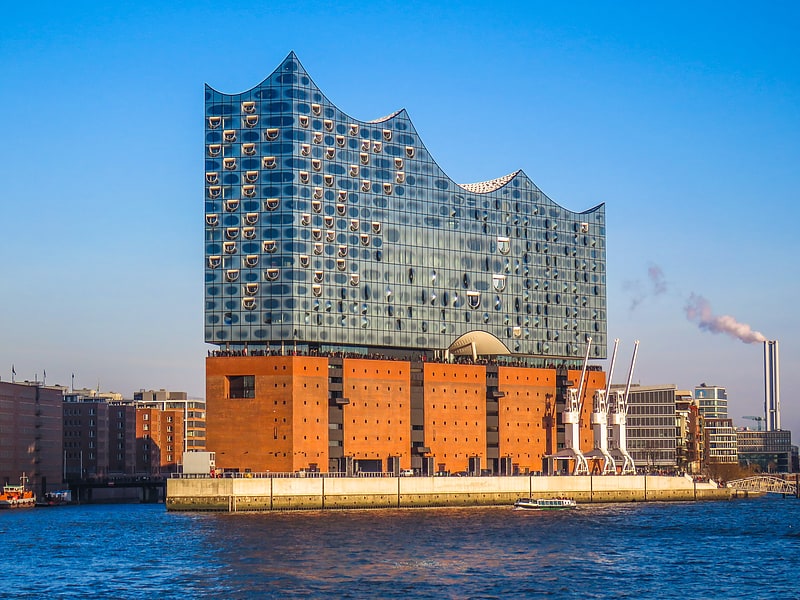
Modern concert hall atop old warehouse. The Elbphilharmonie, popularly nicknamed Elphi, is a concert hall in the HafenCity quarter of Hamburg, Germany, on the Grasbrook peninsula of the Elbe River. It is among the largest in the world.
The new glassy construction resembles a hoisted sail, water wave, iceberg or quartz crystal resting on top of an old brick warehouse (Kaispeicher A, built in 1963) near the historical Speicherstadt. The project is the result of a private initiative by the architect and real estate developer Alexander Gérard and his wife Jana Marko, an art historian, who commissioned the original design by the Swiss architecture firm Herzog & de Meuron, who developed and promoted the project (since 2003 in cooperation with the Hamburg-based real estate developer and investor Dieter Becken) for 3.5 years until the City of Hamburg decided to develop the project by itself. It is the key project of the new Hafencity development and the tallest inhabited building in Hamburg, with a final height of 108 metres (354 ft).
The Elbphilharmonie was officially inaugurated with concerts of the NDR Elbphilharmonie Orchestra and a light show on 11 January 2017.[18]
Address: Platz der Deutschen Einheit 3, 20457 Hamburg (Hamburg-Mitte)
Miniatur Wunderland

Vast model railway with guided tours. Miniatur Wunderland is a model railway, miniature airport, city and many other scenes attraction in Hamburg, Germany, the largest of its kind in the world. The railway is located in the historic Speicherstadt neighbourhood of the city.
In December 2021 the railway consisted of 16,138 m (52,946 ft) of track in H0 scale, divided into nine sections: Harz mountains, the fictitious town of Knuffingen, the Alps and Austria, Hamburg, America, Scandinavia, Switzerland, a replica of Hamburg Airport, Italy and South America. Of the 7,000 m2 (75,347 sq ft) of floorspace, the model occupies 1,545 m2 (16,630 sq ft).
The exhibit includes 1,300 trains made up of over 10,000 carriages, over 100,000 vehicles, approx. 500,000 lights, 130,000 trees, and 400,000 human figurines. Planning is also in progress for the construction of sections for Central America and the Caribbean, Asia, England, Africa and The Netherlands.[19]
Address: Kehrwieder 2-4, 20457 Hamburg (Hamburg-Mitte)
Millerntor-Stadion

Multi-purpose stadium in Hamburg, Germany. Millerntor-Stadion is a multi-purpose stadium in the St. Pauli area of Hamburg, Germany. Best known as the home ground of football club FC St. Pauli, it is on the Heiligengeistfeld near the Reeperbahn, the red light district of Hamburg. The stadium had a capacity of 32,000 when it was built in 1961. It is also used by the Blue Devils American football team, and as a concert venue, including a performance by Prince in 1988. FC St Pauli celebrated their centenary festival at the stadium in 2010.[20]
Address: Harald-Stender-Platz 1, 20359 Hamburg (Hamburg-Mitte)
Brahms Museum
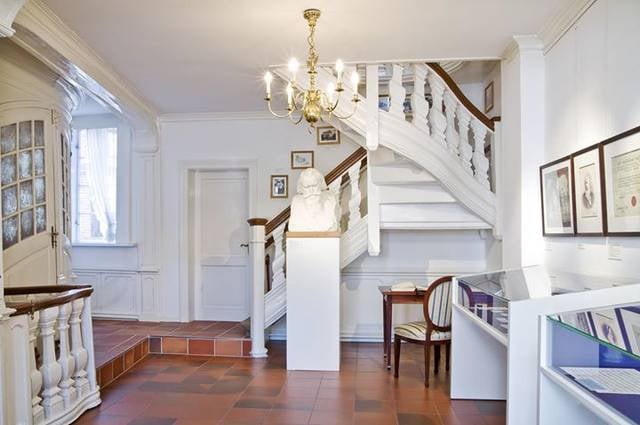
Museum in Hamburg, Germany. The Brahms Museum is a museum in the Composers Quarter in Hamburg-Neustadt, Germany. It is dedicated to the classical composer Johannes Brahms.[21]
Address: Peterstraße 39, 20355 Hamburg (Hamburg-Mitte)
Fanny & Felix Mendelssohn Museum

The Fanny & Felix Mendelssohn Museum is a museum in the Composers Quarter in the Neustadt district of Hamburg, Germany. It is dedicated to the classical composers and siblings Fanny and Felix Mendelssohn. It opened on 29 May 2018.
The museum focuses on their lives, including their childhood and the circumstances in which people of Jewish descent lived and worked within the German culture of the time. In her lifetime, Fanny (1805–1847) wrote the compositions to more than four hundred songs. Felix (1809–1847) was younger than her, and had composed since he was an adolescent. Their mother taught them to play the piano in their early years, but composers including Ludwig Berger, Marie Bigot and Carl Friedrich Zelter later took over the role. The siblings also inspired each other.
In the center, a forte piano symbolizes making music, to which Fanny and Felix were dedicated throughout their lives. Multimedia techniques are used, which enable visitors to go into detail on certain subjects. Visitors can learn how the siblings composed their work and listen to their music. On passing by detection devices audio recordings are activated. The museum opted for a scientifically justified presentation. The musicologist Beatrix Borchard was involved in the planning of the museum.
Construction work delayed the opening by a year. When the museum was opened, the second construction phase had not yet been fully completed. At that time the audio points, touch pads and several display cabinets were still not ready. The limited existence of original pieces was attended to when the museum was fitted out.[22]
Außenalster
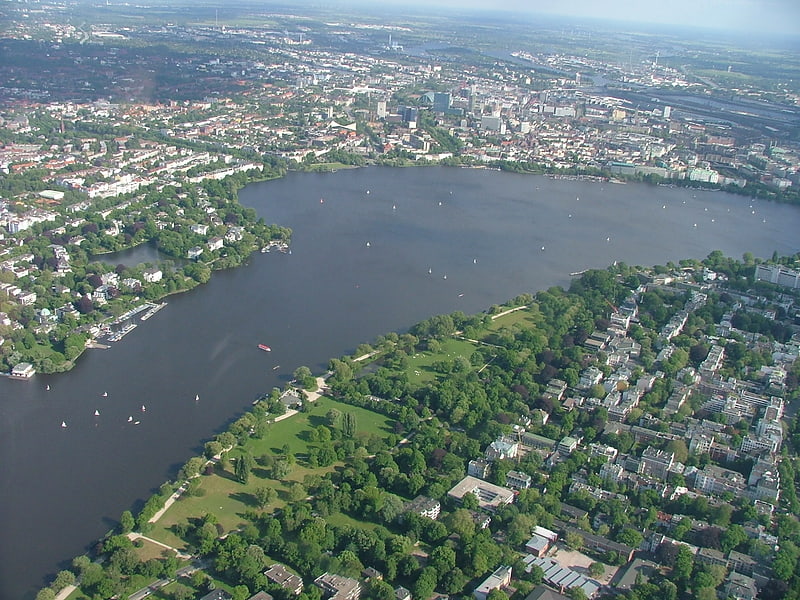
Artificial lake in Germany. Außenalster or Outer Alster Lake is the larger one of two artificial lakes, which are formed by the Alster River and are both located within the city limits of Hamburg, Germany. The other lake is the Binnenalster. The Außenalster and its shores are used by the inhabitants of Hamburg for many sport and recreational purposes, such as sailing and rowing.[23]
Horner Rennbahn
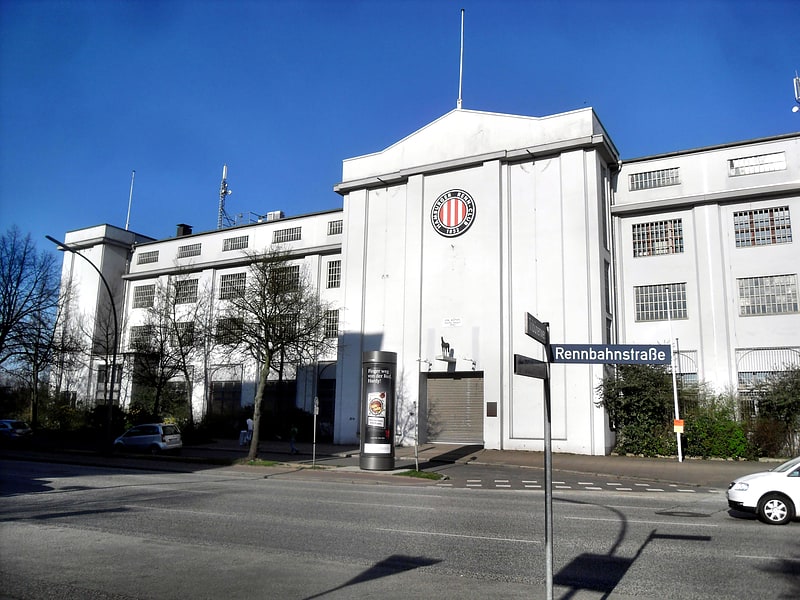
Also known as: Galopprennbahn Hamburg-Horn
Recreation center in Hamburg, Germany. Galopprennbahn Hamburg-Horn, also known as Horner Rennbahn, is a major horse racing venue located in Horn, Hamburg, Germany. It is Germany's oldest horse-racing track, built in 1855. It has a capacity of 50,000 spectators. Since 1869 it hosts the annual Deutsches Derby on distances from 1,000 m to 3,600 m, among others.
The nearest public transit station is Horner Rennbahn station of Hamburg U-Bahn.[24]
Address: Rennbahnstr. 96, 22111 Hamburg (Hamburg-Mitte)
Church of Saint Peter
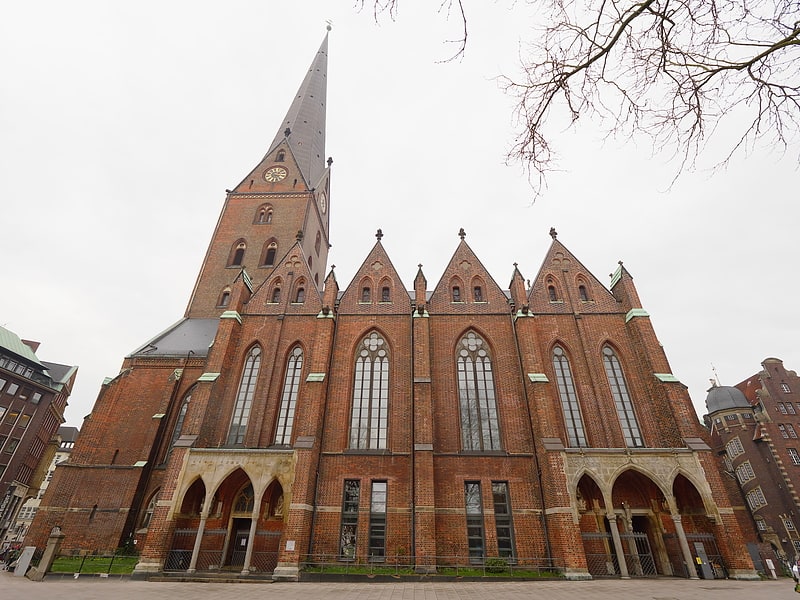
Also known as: Hauptkirche Sankt Petri
Gothic-style church with a sizable tower. Saint Peter's Church in Hamburg, Germany stands on the site of many former cathedrals. Built by order of Pope Leo X, it has been a Protestant cathedral since the Reformation and its congregation forms part of the Evangelical Lutheran Church in Northern Germany.[25]
Address: Bei der Petrikirche 2, 20095 Hamburg (Hamburg-Mitte)
Blankenese Low Lighthouse

Also known as: Leuchtturm Unterfeuer Blankenese
Blankenese Low Lighthouse is a lighthouse on the river Elbe, located in the Hamburg district of Blankenese. The previous one entered into service in 1984 and was demolished in November 2020, but replaced by a similar some 200 m river upwards. Blankenese Low Lighthouse and Blankenese High Lighthouse form a range of lights for ships sailing upriver on the Elbe. With a range of 8.4 Kilometres, they have the longest range on the lower Elbe river.[26]
Heinrich-Hertz-Turm
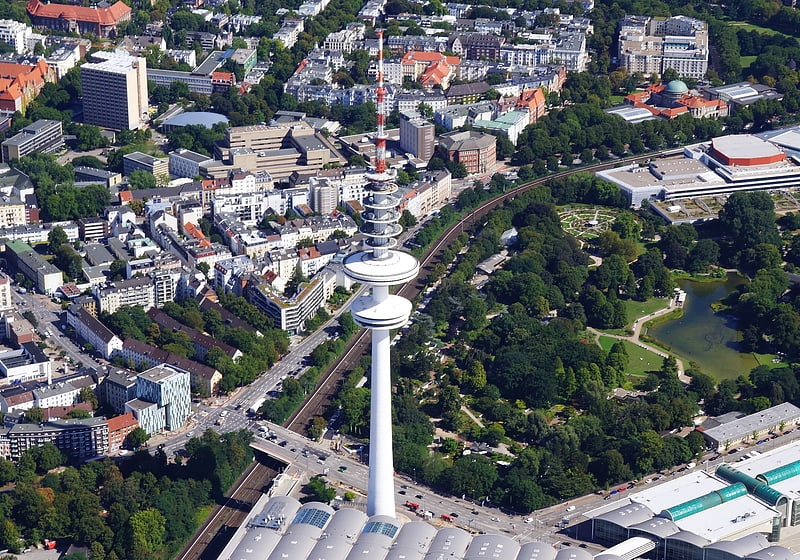
Tower in Hamburg, Germany. The Heinrich Hertz Tower is a landmark radio telecommunication tower in the city of Hamburg, Germany.
Designed by architect Fritz Trautwein, in co-operation with civil engineers Jörg Schlaich, Rudolf Bergermann and Fritz Leonhardt, the tower was built between 1965–1968 for the former Deutsche Bundespost (German Federal Post and Telecommunications Agency, now Deutsche Telekom's subsidiary Deutsche Funkturm GmbH) near Planten un Blomen park.
With an overall height of 279.2 m (916 ft) it is Hamburg's tallest structure, consisting of a 204 m (670 ft) steel-reinforced concrete lower section topped by a 45 m (148 ft) steel-lattice tower and a three-segmented cylinder of about 30 m (98 ft), which supports various antennas. There are eight concentric platforms stacked one above the other: starting at 128 m (420 ft) with the two-story observation (lower floor) and restaurant (upper floor) platform, served by two high-speed elevators. Above that at 150 m (492 ft) is the operations platform housing the workforce and equipment, and further up six differentially sized, smaller open platforms in same distances, populated with high-gain directional microwave radio relay antennas ("parabolic mirrors"). Number nine was added at 25 m height in July 2005.
After the observation platform and restaurant were closed due to asbestos decontamination, former stuntman Jochen Schweizer had a bungee jumping base installed. The restaurant will not open again due to new fire escape regulations, and the bungee platform was closed at the end of 2001.
The tower has been home to the VFDB Hamburg section's radio amateur club station "DF0HHT". It also housed a DGPS transmitting station serving the city of Hamburg's Surveying Agency.
The tower is named after the Hamburg-born German physicist Heinrich Hertz. A memorial plaque in his honour on the tower's wall reads: "Heinrich Hertz – Dem Sohn der Stadt Hamburg" ("Heinrich Hertz - Son of the City of Hamburg").[27]
Address: Lagerstrasse 2, 20357 Hamburg (Hamburg-Mitte)
Museum for Hamburg History
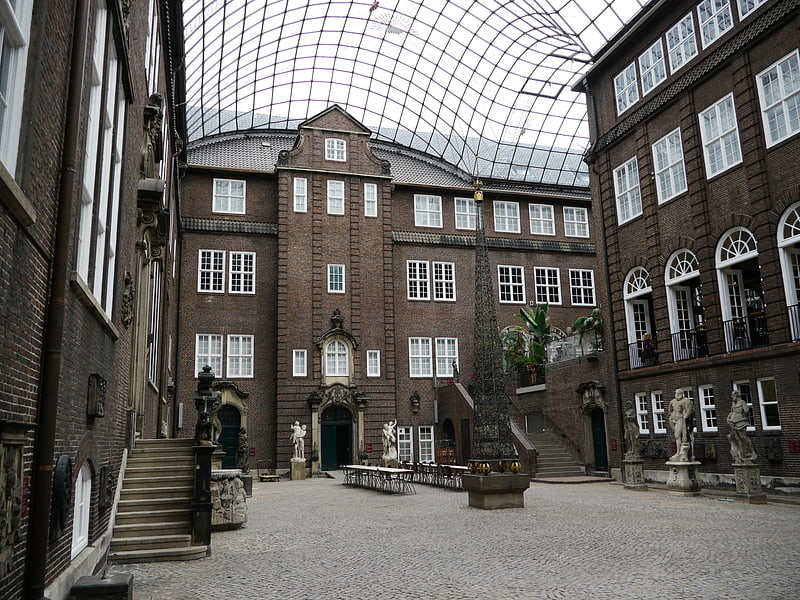
Also known as: Museum für Hamburgische Geschichte
Museum in Hamburg, Germany. The Museum for Hamburg History is a history museum located in the city of Hamburg in northern Germany. The museum was established in 1908 and opened at its current location in 1922, although its parent organization was founded in 1839. The museum is located near the Planten un Blomen park in the center of Hamburg. The museum is commonly reviewed among the museums of the city of Hamburg.[28]
Address: Holstenwall 24, 20355 Hamburg (Hamburg-Mitte)
Planten un Blomen
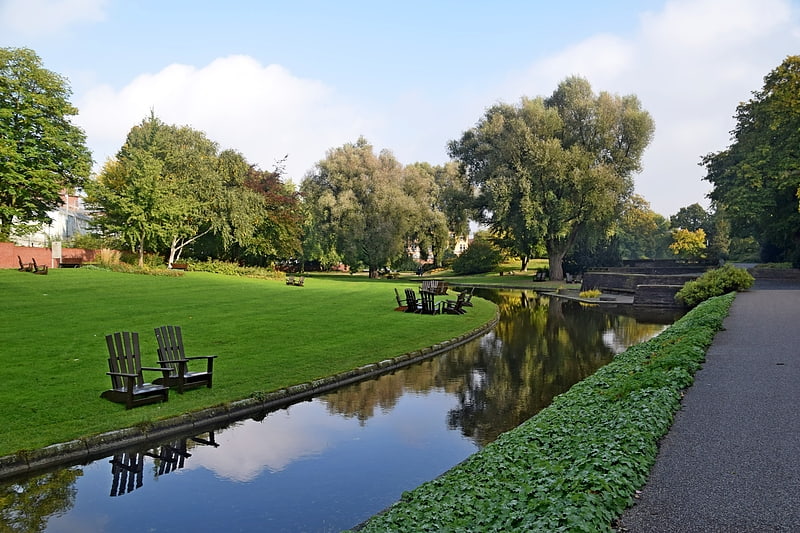
City park with lake and botanical gardens. Planten un Blomen is an urban park with a size of 47 hectares in the inner-city of Hamburg, Germany. The name Planten un Blomen is Low German for "Pflanzen und Blumen" in German or "Plants and Flowers" in English.[29]
Archäologisches Museum Hamburg
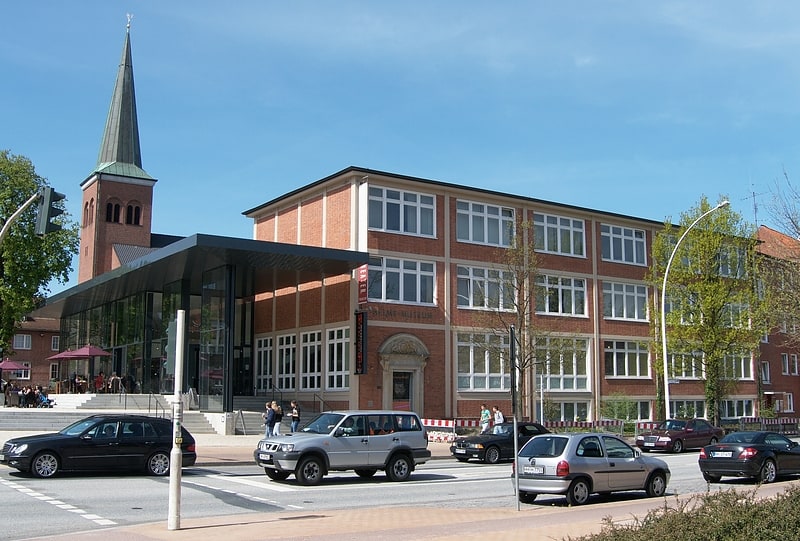
Museum in Hamburg, Germany. The Archäologisches Museum Hamburg is an archaeological museum in the Harburg borough of Hamburg, Germany. It houses the archaeological finds of the city of Hamburg and the neighbouring counties to the south of the city. It focuses on northern German prehistory and early history as well as the history of the former city of Harburg. The museum is also home to the cultural heritage landmarks commission of the city of Hamburg and the adjacent district of Harburg in Lower-Saxony and thus supervises all archaeological undertakings in the region.
The museum has two major exhibition spaces. The future City Museum of Harburg, temporary exhibitions, the library, offices and small storage facilities are located in the main building, which is shared with the Harburger Theater at Museumsplatz 2. The permanent archaeological exhibition and education facilities are located nearby, at Harburger Rathausplatz 5. In addition, the Museum maintains as external branches the exhibition area of the 12th-century Bischofsturm (Bishop's Tower) in Hamburg's old town, the Fischbeker Heide archaeological trail at Neugraben-Fischbek and the 8th-century hillfort of Hollenstedt.[30]
Address: Museumspl. 2, 21073 Hamburg (Harburg)
Hauptkirche St. Katharinen

Also known as: Hauptkirche Sankt Katharinen
Historic church with a notable organ. St. Catherine's Church is one of the five principal Lutheran churches of Hamburg, Germany. The base of its spire, dating from the 13th century, is the second oldest building preserved in the city, after the lighthouse on Neuwerk island. It is situated on an island near what was formerly the southern boundary of the medieval city, opposite the historic harbour area on the Elbe river. It traditionally served as the church of the seamen.[31]
Address: Katharinenkirchhof 1, 20457 Hamburg (Hamburg-Mitte)
Altonaer Museum
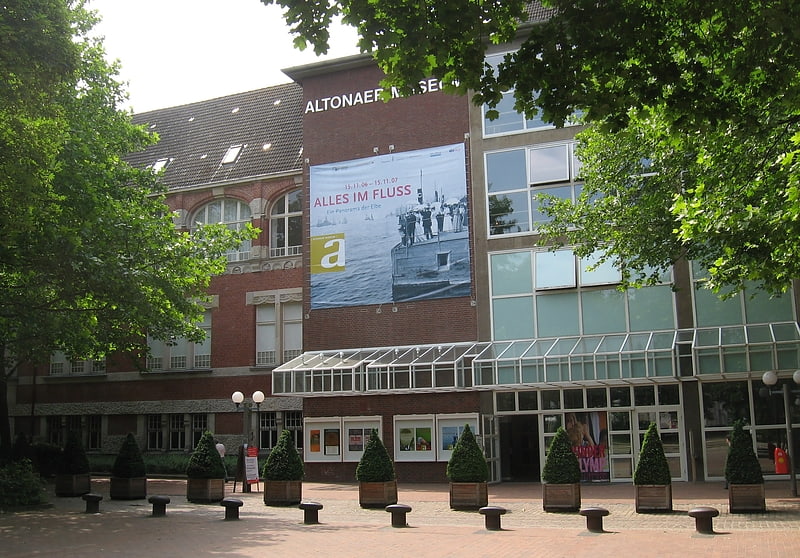
Museum in Hamburg, Germany. Altonaer Museum is an art museum in the suburb of Altona in Hamburg, Germany. The museum association was established in 1863, when Altona was still part of Denmark. The museum has a collection of over 300 000 objects connected to the cultural history of Northern Germany.[32]
Address: 23 Museumstraße, Hamburg (Altona)
BallinStadt
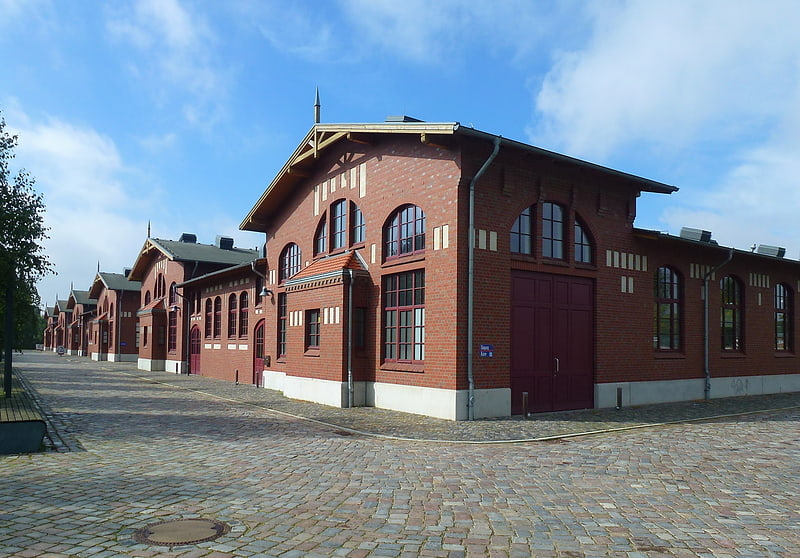
Museum in Hamburg, Germany. BallinStadt is the name given to a memorial park and former emigration station in the Port of Hamburg, Germany.
From the 1850s to the early 1930s the ground's emigration halls were last homestead for some five million emigrants from various parts of Europe, waiting for their departure to the Americas. The BallinStadt museum was opened in 2007 and named after Albert Ballin (1857–1918), then director General of the Hamburg America Line. The site is also marketed as the "Emigration Museum" or "Port of Dreams".
Originally built in 1901, the site's Swiss chalet style quarters provided shelter, lodging and/or entertainment for the emigrants. In 1934 the station was closed and demolished by the Nazis, but rebuilt true to original in the early 2000s. Today, the emigration halls (German: Auswandererhallen) accommodate an exhibition related to the emigrants, their living conditions and experiences during their journeys to and from Hamburg.
The city of Hamburg decided to build the BallinStadt emigration world in December 2004, based on an overall concept developed by the Hamburg Maritim Foundation.[33]
Address: Veddeler Bogen 2, 20539 Hamburg (Hamburg-Mitte)
Dialogue in the Dark
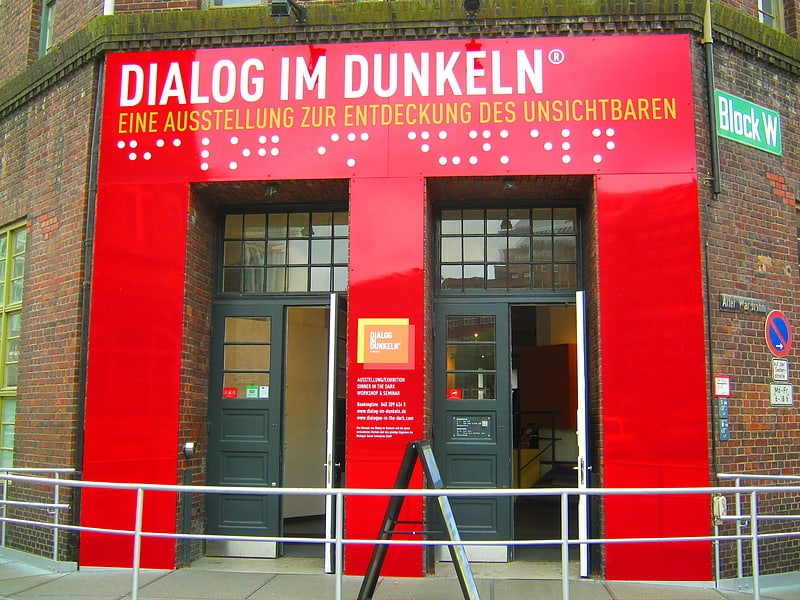
Also known as: Dialog im Dunkeln
Museum in Hamburg. Dialogue in the Dark is an awareness raising exhibition and franchise, as well as a social business. In Dialogue in the Dark, blind guides lead visitors in small groups through different settings in absolute darkness. Through this visitors learn how to interact without sight by using their other senses, as well as experience what it is like to be blind. The exhibition is organized as a social franchising company, which offers the exhibition as well as business workshops, and has created jobs for the blind, disabled, and disadvantaged worldwide. The exhibition aims to change mindsets on disability and diversity, and increase tolerance for “otherness”. More than 9 million visitors have gone through an experience in the Dark and thousands of blind guides and facilitators find employment through exhibitions and workshops.[34]
Address: Alter Wandrahm 4, 20457 Hamburg (Hamburg-Mitte)
Telemann Museum
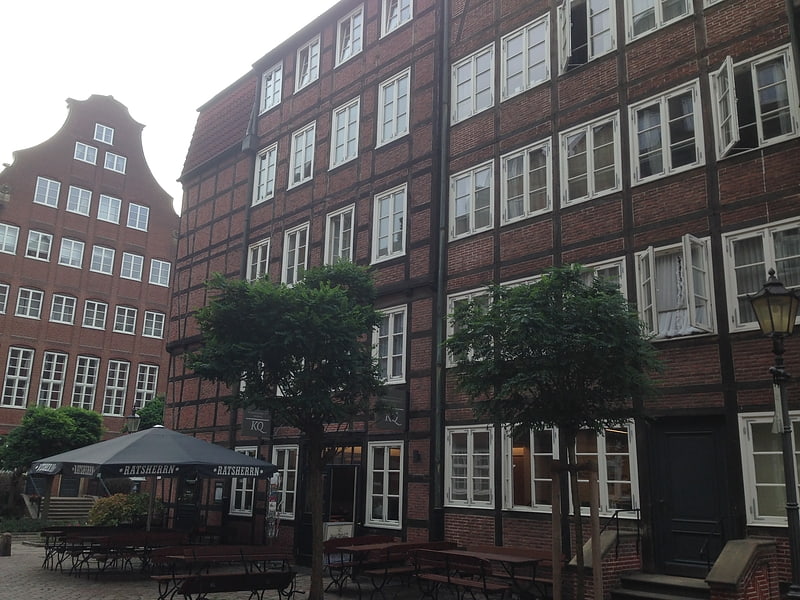
Museum in Hamburg, Germany. The Telemann Museum is a museum in the Composers Quarter in Hamburg-Neustadt, Germany. It was founded in 2011 and is dedicated to the classical composer Georg Philipp Telemann.
The museum is situated in an historical building in the Peterstraße, where Telemann lived and worked from 1721 until his death in 1767. The presentation highlights his personality, including his passion for his botanic garden, and the significance he had musically and culturally in his era.
A great deal of the musical attention is spent to his compositions for the civilians and of church music. The museum houses old archives and maintains an extensive library of books that center around the history of music and culture of the 18th century. The exposition shows first issues and a number of utensils, like an original spinet from 1730 of the builder Thomas Hitchcock. This instrument is used during music performances in the museum.[35]